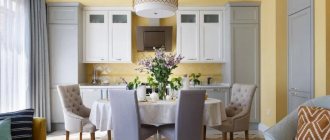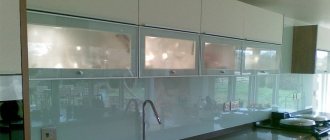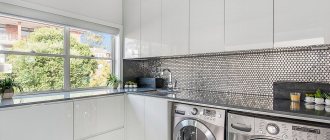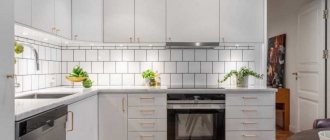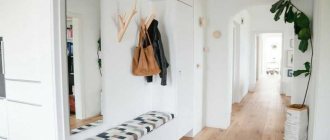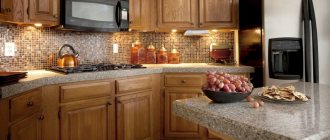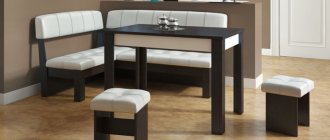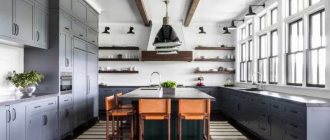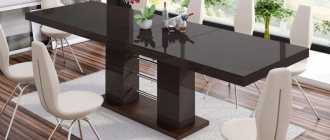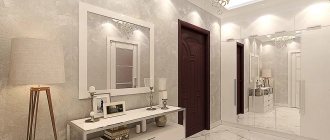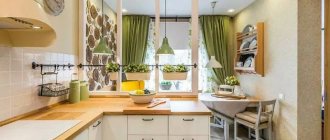Paint or decorative plaster
One of the easiest ways to create an accent in the dining area is to paint one of the walls in a contrasting color.
This option is suitable for those who are just starting renovations and leveling surfaces for painting. Rich shades are self-sufficient on their own, so they often do not need additional decorations, but a poster or wall sconce will help complete the composition. For the kitchen, you need to choose durable paint that will withstand mechanical stress. Such compositions are more expensive than conventional ones, but are not afraid of detergents and do not cause difficulties in care.
Another successful solution is decorative plaster that imitates the texture of fabric, paper, stone or concrete. It looks appropriate both in a classic kitchen and in country, Provence, loft and minimalist styles. The material is durable, resistant to moisture, breathes well and is easy to apply.
Place for sconces
Properly selected light sources will become your faithful assistant in zoning the space.
In the kitchen, attention can be focused on the work area (kitchen set) or dining area. You can also select a resting place, if you have one.
To achieve this goal, hang a chandelier above the table, and install two sconces next to it on the wall.
Built-in lights are useful when arranging the food preparation area. Also hang two wall lights above the sofa.
Local lamps are useful not only for zoning a room, but also for creating the most uniform lighting in a room, guaranteeing a comfortable stay.
This is especially true for spacious rooms. Sconces can be hung along one wall at an equal distance from each other.
If your kitchen is combined with a dining room, then additional lighting may be required above the cupboards and paintings. This will help to harmoniously combine two rooms into one, as well as correctly place accents in it.
Low ceilings are not the best option for installing a central chandelier. You can avoid it altogether by placing several wall lamps around the perimeter of the kitchen. Don't forget to highlight the eating area.
Remember: the light emanating from only one ceiling lamp will visually narrow the walls, so you should not use the chandelier itself in small and narrow rooms.
Even a couple of wall sconces will make the lighting as uniform as possible, which will visually increase the dimensions of the room.
Wall lamps can be used to illuminate paintings and photographs hung on the walls, as well as unusual decorative elements that you would like to place a special emphasis on.
If you have open shelves instead of upper cabinets, or if you prefer a single-level kitchen, then you can safely install sconces directly above the countertop of the work area.
You can also hang sconces above the bar counter, above the stove, or on the free sides of cabinets. There are simply a lot of places to install sconces, so you need to proceed from the individual characteristics of the kitchen configuration and personal preferences.
General rules
Remember that the lower the lamp is located, the lower the ceiling appears, but the more comfortable the local lighting will be. And vice versa - the higher the sconce with the light directed upward, the higher the kitchen will appear;
If you place several sconces around the perimeter of the walls at the same height and distance from each other, the space will visually become wider. The photo below is an example of how light from a sconce can expand a small kitchen, which, moreover, has dark walls and part of the facades that narrow the space;
Chandeliers, floor lamps and, of course, sconces are often produced in accordance with the same collection so that you can decorate the kitchen as a single space. But you can choose sconces not only in combination with a chandelier. The main thing is that the ceiling and wall lamps do not conflict with each other in style, material and color.
Slate coating
Black paint, which is written on with chalk, came to home interiors from schools, as well as catering establishments. It is practical and multifunctional, making it ideal for highlighting the dining area.
You can write notes, favorite phrases, menus and draw patterns on the wall. Dark colors add depth to the room and look original and bold.
Slate coating is easy to make with your own hands. To do this, purchase black acrylic paint and mix it with dry plaster, putty or tile grout. For 100 g of composition, 1 teaspoon of powder is used. It is recommended to test on a small area before painting.
Mirror tiles in interior design
Modern mirror surfaces are made on the basis of acrylic, glass and polystyrene, which is also called mirror plastic. The role of a mirror in a room is enormous. It visually enlarges the space, enhances lighting, decorates and complements the interior. There are many materials with a mirror surface, and there are even more ways to use them in kitchen design.
Sheet panels are most often used to decorate furniture facades or kitchen splashbacks. By the way, a mirror apron is an original thing, but not very popular. Apart from its unusual appearance and visual enlargement of the kitchen, it has no other advantages. The disadvantage is low practicality, such an apron is easy to damage, it will be difficult to keep clean, it looks terrible when fogged up, and the amount of dirty dishes at least doubles. The same cannot be said about the mirror surface at the bar counter; here it will come in handy.
The kitchen interior uses mirror mosaics, tiles of different sizes and shapes. In addition, the mirror can be regular, colored, matted, chrome-plated, aged, with an amalgam pattern or a sandblasted image.
Important! Use mirrors in the interior with caution. Some people find it difficult to be in a room with a large reflective surface.
Brickwork
This design looks great in loft or scandi style. Both authentic masonry, cleared of plaster, and its high-quality imitation in the form of clinker tiles are appropriate. The brick can be natural, aged or painted in any shade - it depends on the overall design of the interior.
The photo shows a spacious loft-style kitchen with metal elements, a table made of natural wood and brickwork.
The brick wall above the dining group is an independent decor if it has a rich texture. And the relief surface, covered with simple white paint, needs an addition - a lamp, a clock or a poster.
The photo shows a brick wall, made with your own hands using plaster and painted in a coral shade.
Materials
The most popular way to decorate a dining area is to use various finishing materials. All of them can be divided into several main groups.
Ordinary wallpaper has remained a popular option for many decades. A huge number of different textures, colors and patterns allow even the most demanding owners to achieve the desired effect. Old paper products have been replaced by thick non-woven wallpaper, the surface of which allows for not only dry but also wet cleaning, which is especially important for surfaces located near the eating area.
Special photo wallpapers will allow you to create the atmosphere of an island bungalow, a small Parisian cafe or a Scandinavian house. And various options with 3D effects will allow you to literally feel the light breeze or the aroma of fresh baked goods.
Brick
Another popular design option for walls near the kitchen counter is brick or various types of stone. This design looks especially interesting if a high bar counter replaces a regular table.
Tile
The classic solution for kitchen walls is ceramic tiles. This is the most convenient and durable way of decoration. A large number of styling options allow you to create original patterns even from plain squares. And many options with different patterns and even entire paintings allow you to choose the perfect pattern for each specific kitchen.
Panels
Plastic or wooden panels that line the wall in the dining area are also an excellent way to decorate it. Natural materials beckon you to touch them with your palm, and a large number of ornaments and colors of plastic will make the choice easier.
Plaster and paint
Simple plastered and painted walls can also act as a stylish accent that attracts the eye. For example, if the entire kitchen is made of plastic and metal, then the monotonous and calm surface of the painted wall will attract attention and give the eyes rest.
Photo wallpaper or fresco
An excellent solution for small kitchens is the use of canvases that visually expand the space. If the eye rests on an empty wall, the room appears smaller, but when it slides “deeper” into the image, the opposite effect occurs.
In the photo there is a wall near the dining table, decorated with wallpaper with a seascape. Thanks to the installed glass, the panel appears deeper and thereby imitates a window.
For the coating to look stylish, the elements on it must echo the details of the kitchen furnishings - textiles, aprons or facades. The canvas looks more expensive if it has a slight texture.
Wall design near the table in the kitchen
Any meal can be much more enjoyable when the surroundings are thoughtful and enjoyable. And we are talking not only about various cafes and restaurants, but also about ordinary kitchens in houses and apartments. Often, the square footage of modern housing does not allow organizing a separate room for eating, so lunches and dinners are held at the kitchen table. To make the place for family gatherings and tea parties pleasing to the eye, you need to carefully consider the entire furnishings of the room. And the first thing you should pay attention to is the design of the wall near the dining table.
Mirror
Decorating a wall near the dining area with a mirror is a non-trivial and functional solution. The canvas instantly increases the space, so this is a great option for a small kitchen. Reflection adds airiness to the atmosphere, complicates the geometry and even increases appetite.
A mirror in a figured frame or several small items in a metal frame will add elegance and a certain solemnity to the kitchen. Another obvious advantage of a mirror is that it multiplies the amount of light and therefore helps out when there is a lack of lighting.
Colors
An important place in decorating dining areas is occupied by the color scheme of finishing materials. In order to make a choice taking into account not only personal preferences, but also general perception, you need to know exactly how a particular color affects a person.
- Red and yellow. These colors increase appetite and create an atmosphere of warmth and comfort. However, a large amount of bright red color has a depressing effect on the human psyche, so it is better to decorate the dining area in soft shades of orange and yellow.
Niche
An artificially created niche, inside which a dining table is placed, helps to make the kitchen environment more expressive and private. The structure can be made of plasterboard and decorated with clinker tiles, or use shallow cabinets.
The second option is more practical, as it plays the role of an additional storage system for dishes or workpieces. But such a solution is appropriate only in spacious kitchens with an area of 9 square meters and above.
Decoration with modular paintings
Modular paintings, also known as polyptychs, are created by dividing an image into several separate parts. They appeared relatively recently, but due to their originality and low cost they quickly became popular. For the kitchen, you can choose a ready-made picture or print any selected photo. The image can be transferred to canvas, photo paper, wood, glass. It can also be aged using a special craquelure gel.
Modular paintings in the kitchen interior should be used correctly, then they will be helpers and not pests. Decor should be chosen in accordance with the dimensions of the room. Small posters look good on narrow walls, and large ones on wide and tall ones. The width of the picture is no more than 75% of the furniture underneath it. The theme should complement the interior and create a mood. For the kitchen, images of flowers, fruits, and landscapes are most often chosen. The most popular modular paintings consist of several parts that are placed horizontally, but there are also more complex models that combine several forms. A picture with an odd number of elements looks most harmonious.
They are hung according to the same rules as ordinary canvases: the central point is at eye level. For the dining area, you can make an exception: hang the picture a little lower.
Dishes
A charming technique that is gaining popularity again. To make the decorative elements look harmonious, we recommend choosing plates in the same style, but of different sizes.
The photo shows a dining table, above which there is a composition of plates with mirrors on the sides.
A good idea is to paint the plates yourself using acrylic paints. This is not at all difficult if you think through the theme in advance: it is better to start with ornaments and abstractions. To give your creations shine and protect them from the effects of wet cleaning, you need to coat them with varnish.
Features of the zone
Unlike other rooms, kitchen walls have their own specifics. Most often, cooking is associated with high humidity, splashes of fat and other contaminants. It is for this reason that a kitchen apron made of the most hygienic material should always be installed in the work area. The place where food is eaten is subject to more lenient requirements that differ from the rest of the room.
- Practicality. It is not necessary to cover the wall behind the dining table with ceramic tiles or plastic panels. However, it is better to choose a material that can be washed or wiped with a damp cloth to remove dirt.
- Safety . Avoid placing the table near protruding corners and door frames. In addition, you cannot hang heavy hanging shelves with dishes or household supplies on this wall.
- Aesthetics. You need to have breakfast, lunch and dinner in a place that pleases the eye. It is not necessary to make expensive renovations in the kitchen and order the services of a designer. However, a large empty surface, into which the gaze of a person sitting at the table will rest, will also not contribute to a feeling of comfort. Of course, you can always hang a TV on the wall, but medical research has repeatedly provided many arguments against watching TV while eating.
